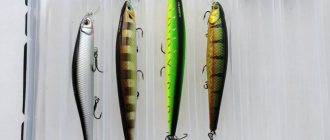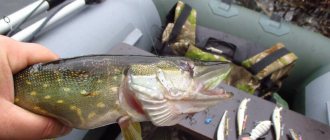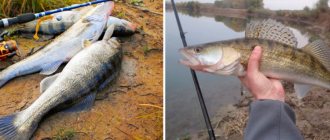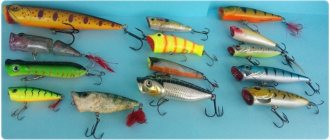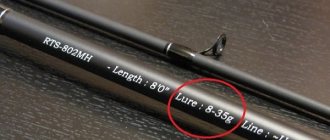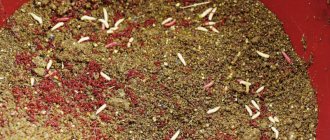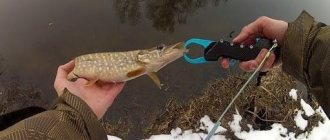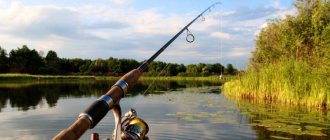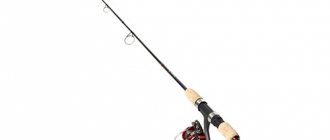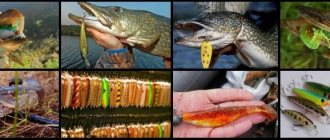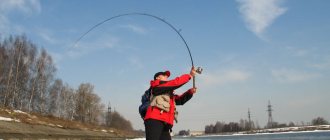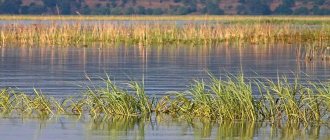Pike fishing spots
Pike spawn in early spring, but not all at the same time. Young individuals begin to spawn, with the largest specimens being the last to spawn. This occurs at water temperatures from 4 degrees to 10-12. Spawning itself coincides in time with the migration of waterfowl - so pike eggs appear in all possible places. This explains the presence of this species in any water bodies.
Even in severe frosts, in non-freezing areas of water, spinners try to catch this fish, especially near power plants.
On a large reservoir or river, for example, in the Moscow region, it is possible to catch pike both from the shore and from a boat by trolling. When fishing from a boat, large summer baits are used. At this autumn time, pike can be caught with any bait, in different ways and in any place, even unexpected for the angler. In a special way, neither the nature of the wiring nor the depth of the bait are particularly important.
Where to catch pike in the fall with a spinning rod?
We analyzed pike fishing locations based on fishermen's reports and marked points on the map where we did not return without a catch.
Where to fish in October - November?
As for choosing a reservoir, it’s all up to the fisherman. It is very good if the fisherman has the opportunity to choose. But most often the choice is small and those reservoirs where the last September fishing trips were the most productive are preferred.
In most regions of our Motherland there are small rivers with medium and fast currents, which are very well suited for October fishing with spinning rods. You can also achieve good results when fishing for pike in large reservoirs and large lakes, if you know, of course, where its pre-winter “station” is located.
Pike fishing in autumn
Already cold nights, frequent rains and northern winds chill the surface of the water. This surface layer goes down and is replaced by water from the warm middle layer. By the end of September, all the water is mixed and becomes the same temperature. The oxygen concentration is also the same throughout the entire depth. And such changes are reflected in the behavior of fish. Now they have the same conditions throughout the aquatic environment.
In the fall, sexual cells begin to mature in mature pikes. They need growth energy. From September, pike begin their long autumn feeding period.
Disadvantages of autumn fishing
Firstly, pike bite differently when the wind direction changes over a body of water. Every time it is difficult to predict the result of fishing.
Secondly, changes in atmospheric pressure also affect pike feeding. Low pressure has a positive effect on its activity, high pressure - on the contrary. Moreover, the pressure should remain for several days. The stability of the pressure is more important than its magnitude.
Pike fishing calendar
Fishing for pike in September using a spinning rod can be very productive. All spinning fans are looking forward to this season. As the water temperature drops, pikes emerge from the pits into the open water.
Before winter, fish actively feed throughout the water surface. So the pike has to look for food everywhere. She grabs everything that moves nearby.
But all the same, on every body of water there are places where pike in one place are better taken with a spinner, in another place it’s better with a spinner. Every spinner should have a set of his favorite baits, which he knows thoroughly and knows how to use.
Fishing for pike in October using a spinning rod under favorable weather conditions can be even more productive than in the sometimes warm September. The zhor continues, it stretches until the freeze-up. You can catch a good fish throughout the day, especially on cloudy and rainy days.
In October, small fish lose their hiding places from predators as aquatic plants die off. The transparency of the water and the autumn heat make pike hunt all day long. The spinner doesn't have to waste time!
Where to look for pike in autumn in October
You just need to observe in the reservoir where peaceful fish may be at this time. Usually it gathers in flocks and approaches wintering pits. There, in deeper places, you need to look for the predator.
Fishing for pike in November using a spinning rod
In November, fishing for this fish is quite effective. But the situation in nature is changing. The water already has a temperature of 8-10 degrees. During this period, fish settle in schools for the winter. And pike are inactive during this period, especially noticeable in large bodies of water. Having a lot of food in such places, they have already eaten and are now resting.
Another thing happens in small floodplain reservoirs, where there is little food. And the pikes here begin to grab all living things. Once in such a place in November, an angler can catch as many of them as he wishes.
You can fish in November both in the morning and in the evening, and in any weather. You don’t have to spend a lot of time choosing bait—any bait will do. The main thing for this kind of fishing: a strong rod.
Fishing tactics and bait
The tactics for catching passive pike is to choose the right bait and how to present it. The skill of a spinner is determined by how quickly he can identify the right bait, move it correctly, and provoke an attack from a predator.
The best artificial bait for catching inactive pike is one that will provoke the predator to attack. And to find it, you need to experiment. In the arsenal of even a beginning spinning player, a priori there should be baits of different types, types, shapes and sizes: wobblers, rotating and oscillating spoons, silicone imitations.
If weather conditions indicate that pike activity will be low, but you want to catch it, there are several general tactics that you need to adhere to:
- You should choose bait based on specific fishing conditions, fishing location and weather. Weather and fishing season seriously affect the predator’s stopping places;
- Quite often, when catching a low-active predator, wobblers occupy a leading position. A wobbler for passive pike is the best bait that maximally imitates the appearance of live fish;
- any selected bait should be served as close as possible to the promising fishing point;
- The fishing tactic for passive pike is slow reeling. Moreover, this can be a twitching method or even stretching. A low speed will lead to fewer promising places being fished, but will increase the possibility of an attack by a “sleeping” predator.
The prospect of lengthy experiments should not frighten an inexperienced fisherman. In this case, there are no dogmatic norms and patterns as to why pike reacts to some baits and does not notice others. And an experienced fisherman differs from a novice amateur in that he is not afraid to solve the most complex pike puzzles.
TAGS:
What gear should I use to catch pike in the fall?
Of course, the most successful tackle will be a spinning rod. For the beginning of autumn with even more vegetation, a medium-class form with a length of up to 240 cm and a dough of up to 25 g is suitable.
At the end of October and November, all vegetation disappears, then long-distance casts will be the most successful. Here you need a fast action spinning rod up to 270 cm long.
The reel must be of high quality, because it is very possible to hit a large specimen. A fishing line of 0.25 mm is suitable.
Pike lures
Lures for catching pike in the fall can be varied. After all, at this time the predator is very active and can grab everything that swims near it.
The most widely used baits at this time are:
- oscillating spoons; is a metal plate bent in a different profile. Having low resistance, the spinner plays even with slow retrieval. Moreover, having a decent mass, it is thrown over an impressive distance;
- a rotating spinner (spinner) consists of an oval metal petal placed on a rod, its rotation creates sound vibrations;
- soft silicone baits - all kinds of fish, worms, twisters, vibrotails. These baits, unlike spinners and wobblers, are effective in any fishing conditions. This is explained not only by their great similarity with living organisms, but also by their behavior in water. Soft baits do not lose their constant play in any current and with any wiring.
- wobblers are baits very similar to live fish. They are expensive in price, but worth it.
The main factor in choosing baits in the fall is their larger size than in the summer. In accordance with this, a larger test of the rod is needed. When choosing a color, all bright shades are suitable; red color is especially attractive to pike.
Spinning and equipment
Spinning and equipment in the autumn period should be more powerful, since, unlike the hot summer period, the predator is already active and furious on the hook. The form of the spinning rod must correspond to the fishing conditions, that is, its length is chosen for coastal fishing or for fishing from a boat. In the first case, you can use a rod 2.4 meters long or a little longer, and for fishing from a watercraft, a spinning rod 2 meters long is suitable. The test indicators of such a rod should correspond to the weight and size of the bait, that is, be in the range of 20-50 grams. This is for reservoirs. On small rivers, the test may reach a maximum of 25 grams. Since heavy large baits are used in the fall, and the depth of penetration can reach 6-8 meters, it is better to choose a blank with a fast or medium-fast action, that is, relatively hard.
Coil
The same goes for the reel. Its formula must be no less than 3000, and the traction mechanism must be equipped with at least 4 bearings. It is better to use a metal spool. It is advisable to equip it with a braided cord with a diameter of 0.14-0.16 mm, depending on the fishing conditions. The use of monofilament fishing line also occurs, but its diameter must be at least 0.25-0.3 mm. And here you should not save on the price of fishing line. It is better to take a product from Japanese companies so as not to lose a trophy specimen of pike, which is the largest one caught in the fall.
Leash
A metal leash is included in the mandatory set of equipment elements, otherwise loss of prey may become the rule. When the autumn pike is active, it will not cost it any effort to cut or break the leash from the fishing line, even if it is thick fluorocarbon. Titanium, tungsten, and steel leaders are usually used. Often they use twisted steel wire or the same guitar string. This is usually the first string of a musical instrument. It is advisable to use stainless steel rings. Otherwise, the ring, which is susceptible to corrosion, may fail at the most crucial moment.
Pike fishing tactics
Statistics say that the largest freshwater fish are pike. Sometimes individuals up to 15 kg are found.
The bite of a large predator is heard by the fisherman as the bait being caught on an underwater obstacle. The big fish does not react to pain, goes right to the bottom and does not want to give up. Only by holding it on a tight line can you tire it out.
But there is no need to force the fishing of pike. Even at the very feet of the fisherman, she can make a throw. And in this case, there is no need to hold it - the fishing line will break or the spinning rod will break. It’s better to let the pike go like this several times, and when exhausted, it will allow itself to be calmly taken by the landing net.
It is necessary to remove the bait only when the fish has finally calmed down. Sharp teeth can injure the angler's hand, so a yawner or extractor is used for extraction.
Fluorocarbon line
Fluorocarbon line appeared on the market almost at the same time as braided line. It is made of a special polymer, which has almost the same refractive index of light as that of water, so it is practically invisible to fish, for which it is valued by fishermen.
It also has other advantages:
- fluorocarbon fishing line does not have a memory effect (for example, an elongated fishing line does not curl into rings, that is, the fishing line does not “remember” the shape of the reel on which it was wound);
- wear resistance;
- stretchability is present, but it is not as great as compared to monofilament;
- does not absorb water, so it has a longer service life compared to conventional fishing line without losing its original strength.
The main disadvantage of fluorocarbon fishing line is its lack of strength. Therefore, it is most often used for leashes, and not as the main fishing line. However, better leashes than fluorocarbon are hard to find. They even make leashes for pike fishing from fluorocarbon fishing line of increased diameter. Another disadvantage of fluorocarbon is its cost. The cheapest fishing lines cost at least 150 rubles per reel.
Tips for fisherman: What gear is needed for pike fishing - What is the difference, pros and cons
Fluorocarbon fishing lines are ideal as leaders. It’s rare that a leash is longer than three meters; one reel with one hundred meters of fluorocarbon is enough for many leashes. It's worth spending money on them.
Pike is a fairly large and agile breed of fish, equipped with very sharp teeth, with which it can easily bite through the fishing line if it is not fed correctly. Accordingly, the choice of this equipment must be approached with the utmost seriousness.
Monofilament line
Monofilament fishing line has a high level of strength and is able to hold even fairly large fish, avoiding breaks and excessive tension. It also stretches perfectly, and this fact can be attributed to both the pros and cons of this equipment component. The fishing line has such a peculiar property as the presence of “memory”, that is, once stretched, it will not return to its original state, which affects its service life, which due to this circumstance is significantly reduced.
Braided fishing line
Video with reviews of different braids. Information on choosing a good braid for spinning.
Fluorocarbon line
The material from which fluorocarbon fishing line is made creates an absence effect when it gets into the water, that is, it is almost invisible. Also, this equipment has a low memory effect and, accordingly, practically does not deform when over-stretched, returning to its original shape. The main disadvantages of this type of fishing line include such characteristics as insufficient strength and an excessively high level of rigidity, which makes the gear excessively fragile.
The actual question is how far the spinning rod will be cast. A thin cord with low windage delivers the bait to the maximum distance from the shore. The material of the cord must withstand not only all the reliability criteria of the accessory, but also all the fighting attacks of the predator during the fishing process. This means that a particularly thin fishing line is not suitable here; strength is important. But if the fish decides to behave more submissively, it will not resist much, the large thickness of the fishing line will become a hindrance and will coarse all the parameters of the tackle.
